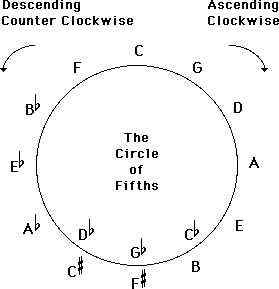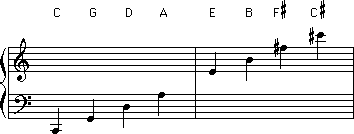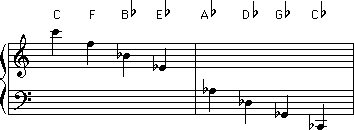
In the circle of fifths diagram each note is a perfect fifth (seven half steps) away from its immediate neighbors. You can move through the circle of fifths in two directions, clockwise and counter clockwise. If you start at any point on the circle and move clockwise or counter clockwise through 12 consecutive fifths, you’ll end back at your starting note and will have used all 12 chromatic pitches in the process.

Clockwise motion moves through a series of ascending perfect fifths.

When written on a single staff clockwise motion may be written as a series of ascending perfect fifths alternating with their inversion, descending perfect fourths

Counter clockwise motion moves through a series of descending perfect fifths.

When written on a single staff, counter clockwise motion moves through a series of descending perfect fifths alternating with their inversion, ascending perfect fourths.

The names of the major sharp scales follow the ascending circle of fifths: C G D A E B F# C#
| Major
Scale Name |
Number
of Sharps |
Scale |
| C |
0 |
|
| G |
1 |
 |
| D |
2 |
|
| A |
3 |
 |
| E |
4 |
|
| B |
5 |
 |
| F# |
6 |
|
| C# |
7 |
|
The names of the major flat scales follow the descending circle of fifths: C F Bb Eb Ab Db Gb Cb
| Major
Scale Name |
Number
of Flats |
Scale |
| C |
0 |
|
| F |
1 |
 |
| Bb |
2 |
 |
| Eb |
3 |
 |
| Ab |
4 |
 |
| Db |
5 |
|
| Gb |
6 |
 |
| Cb |
7 |
|
The names of the minor sharp scales follow the ascending circle of fifths: a e b f# c# g# d# a#
| Minor
Scale Name |
Number
of Sharps |
Scale |
| A |
0 |
|
| E |
1 |
 |
| B |
2 |
|
| F# |
3 |
 |
| C# |
4 |
 |
| G# |
5 |
 |
| D# |
6 |
|
| A# |
7 |
 |
The names of the minor flat scales follow the ascending circle of fifths: a d g c f bb eb ab
| Minor
Scale Name |
Number
of Flats |
Scale |
| A |
0 |
|
| D |
1 |
|
| G |
2 |
 |
| C |
3 |
|
| F |
4 |
 |
| Bb |
5 |
 |
| Eb |
6 |
 |
| Ab |
7 |
 |
As the number of sharps used in each scale increases, the sharps used in previous scales remain in effect. The order that the new sharps are added follows the ascending circle of fifths: F# C# G# D# A# E# B#. The order of sharps in minor scales follows the same pattern.
| Major
Scale |
Minor
Scale |
Num.
Sharps |
1 | 2 | 3 | 4 | 5 | 6 | 7 |
| C |
A |
0 |
|||||||
| G |
E |
1 |
F# | ||||||
| D |
B |
2 |
F# | C# | |||||
| A |
F# |
3 |
F# | C# | G# | ||||
| E |
C# |
4 |
F# | C# | G# | D# | |||
| B |
G# |
5 |
F# | C# | G# | D# | A# | ||
| F# |
D# |
6 |
F# | C# | G# | D# | A# | E# | |
| C# |
A# |
7 |
F# | C# | G# | D# | A# | E# | B# |
As the number of Flats used in each scale increases, the flats used in previous scales remain in effect. The order that the new flats are added follows the descending circle of fifths: Bb Eb Ab Db Gb Cb Fb. The order of flats in minor scales follows the same pattern.
| Major
Scale |
Minor
Scale |
Num.
Flats |
1 | 2 | 3 | 4 | 5 | 6 | 7 |
| C |
A |
0 |
|||||||
| F |
D |
1 |
Bb | ||||||
| Bb |
G |
2 |
Bb | Eb | |||||
| Eb |
C |
3 |
Bb | Eb | Ab | ||||
| Ab |
F |
4 |
Bb | Eb | Ab | Db | |||
| Db |
Bb |
5 |
Bb | Eb | Ab | Db | Gb | ||
| Gb |
Eb |
6 |
Bb | Eb | Ab | Db | Gb | Cb | |
| Cb |
Ab |
7 |
Bb | Eb | Ab | Db | Gb | Cb | Fb |
Revised by John Ellinger, Spring 2012.